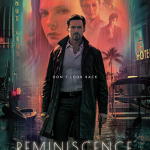A “spiritual sequel” to the horror film Candyman (1992) that returns to the now-gentrified Chicago neighborhood where the legend began.
Pam says:
Knowing that Peele had a hand in the writing, you immediately know that you’re in for surprises and societal statements. He does not disappoint. His keen understanding of storytelling and surrounding himself with the talents of his co-writers, director and of course, the cast allow him to create a genuinely unique and captivating story. We also see the genre of horror with all its tropes push the envelope to become something far superior. It challenges us to look more deeply into our history and our knowledge base to actually see things for what they are. And at the same time we are thoroughly entertained.
To read Pam’s review in its entirety, go to http://reelhonestreviews.com/candyman-surprisingly-complex-and-relevant-horror-film-breaks-the-mold-of-the-genre/
Chuck says:
Reboots are a tricky thing – how do you match the success of a previous film yet provide something new and vital while avoiding the pitfall of simply going over the same narrative ground? Director Nia DaCosta proves she’s more than up to the task of avoiding this trap with “Candyman,” an update of the 1992 cult horror movie that manages to not only successfully pay homage to the original but expand upon its premise in a new, dynamic way. Co-written and co-produced by Jordan Peele (“Get Out”), it should come as no surprise that societal concerns are woven into this update, adding a layer of not only relevance but genuine horror to the premise.
In order to get everyone up to speed, DaCosta utilizes die-cut puppetry to tell the story of the Candyman, the urban legend summoned whenever anyone is foolish enough to look in the mirror and say his name five times. This is done by Troy (Nathan Stewart-Jarrett) who recounts the tale for the benefit of his sister Brianna (Teyonah Parris) and her boyfriend, artist Anthony McCoy (Yahya Abdul-Mateen) one evening at dinner. His reasoning for such a gruesome tale? Why to point out that her posh loft apartment sits on the very site where the killer’s exploits took place. Chicago’s infamous housing project, Cabrini-Green has been razed, the high-rise where Brianna and Anthony are living just one of many that now reside on the spot where it once was.
While Brianna brushes aside the story as nothing but a silly story told by teenagers, Troy is intrigued, so much so he decides to explore the roots of the story, finding those who were alive during the killer’s murder spree so that they might provide more information about him. Inspired, he does a series of paintings inspired by the legend, something that causes a sensation in the Windy City art world, gaining him the sort of notoriety he’s always craved. Unfortunately, there’s a price to pay for exploiting these acts for personal gain and once a series of copycat killings are committed, those in the know fear the supernatural madman has returned.
DaCosta proves more than capable of creating a sense of tonal dread and ominous atmosphere, the gleaming new buildings suffused with perpetual shadows, the shine of the apartments muted throughout. The past is a constant presence, the shadows and overcast look of the movie reminding us that it is inescapable. This becomes all the more prevalent when the background of the Candyman is revealed as Peele, DaCosta and co-writer Win Rosenfeld fold in scenes of historical oppression, racism and gentrification into the story. These issues cast a pall over the setting and all who fail to acknowledge these deeds or attempt to profit by them, ultimately pay a dire price at the hands of the titular character.
DaCosta and her two co-writers fail to stick the landing, as they attempt to tie up every narrative strand in the most expedient fashion, eschewing imagination or ambiguity in the process. Still, it’s far better than Peele’s confused and overrated Us, as the connections made between historical vagaries and their continued impact to present day are clearer and, as a result, more powerful. There’s more than enough ingenuity at play during the film’s first two acts to make “Candyman” worth taking in, a feature that serves notice that DaCosta is a director worth watching.
3 Stars




